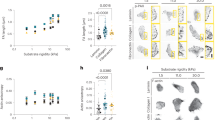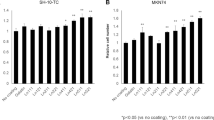Abstract
Laminin, a major structural multidomain protein of basement membranes, has been shown to exert a variety of biological activities. Prominent among those are mediation of cell attachment as well as influences on cellular proliferation, differentiation and motility. Distinct domains of laminin have been identified which carry these activities. The active sites on laminin are recognized by cellular receptors, several of which belong to the integrin class of heterodimeric transmembrane proteins. These are in direct contact with intracellular proteins and mediate signals from the extracellular matrix to the cytoskeleton and possibly to other intracellular regulatory systems. The biological activities of laminin may be used to design optimal conditions for the expression of a differentiated phenotype of cells in culture.
Similar content being viewed by others
Abbreviations
- EHS tumor:
-
Engelbreth-Holm-Swarm tumor
- EGF:
-
epidermal growth factor
- NGF:
-
nerve growth factor
- FGF:
-
fibroblast growth factor
References
Acheson A, Edgar D, Timpl R and Thoenen H (1986) Laminin increases both levels and activity of tyrosine hydroxylase in calf adrenal chromaffin cells. J. Cell Biol. 102: 151–159.
Adler R, Jerdan J and Hewitt AT (1985) Responses of cultured neural retinal cells to substratum-bound laminin and other extracellular matrix molecules. Dev. Biol. 112: 100–114.
Akiyama SK, Nagata K and Yamada KM (1990) Cell surface receptors for extracellular matrix components. Biochim. Biophys. Acta 1031: 91–110.
Albelda SM and Buck CA (1990) Integrins and other cell adhesion molecules. FASEB J. 4: 2868–2880.
Armant DR, Kaplan HA and Lennarz WJ (1986) Fibronectin and laminin promotein vitro attachment and outgrowth of mouse blastocysts. Dev. Biol. 116: 519–523.
Aumailley M and Timpl R (1986) Attachment of cells to basement membrane collagen type IV. J. Cell Biol. 103 1569–1575.
Aumailley M, Nurcombe V, Edgar D, Paulsson M and Timpl, R.. (1987) The cellular interactions of laminin fragments. Cell adhesion correlates with two fragment-specific high affinity binding sites. J. Biol. Chem. 262: 11532–11538.
Baron-Van Evercooren A, Kleinman HK, Ohno S, Marangos P, Schwartz JP and Dubois-Dalcq E (1982) Nerve growth factor, laminin, and fibronectin promote neurite growth in human fetal sensory ganglia cultures. J. Neurosci. Res. 8: 179–193.
Beck K, Hunter I and Engel J (1990) Structure and function of laminin: anatomy of a multidomain protein. FASEB J. 4: 148–160.
Cohen J., Burne JF, Winter J and Bartlett P (1986) Retinal ganglion cells lose response to laminin with maturation. Nature 322: 465–467.
Cohen J, Burne JF, McKinley C and Winter J (1987) The role of laminin and the laminin/fibronectin receptor complex in the outgrowth of retinal ganglion cell axons. Dev. Biol. 122 407–418.
Davis GE, Manthorpe M, Engvall E and Varon S (1985) Isolation and characterization of rat Schwannoma neurite-promoting factor: Evidence that the factor contains laminin. J. Neurosci. 5: 2662–2671.
Dean JW, Chandrasekaran S and Tanzer ML (1990) A biological role of the carbohydrate moieties of laminin. J. Biol. Chem. 265: 12553–12562.
Deutzmann R, Aumailley M, Wiedermann H, Pysny W, Timpl R and Edgar D (1990) Cell adhesion, spreading and neurite stimulation by laminin fragment E8 depends on maintenance of secondary and tertiary structure in its rod and globular domain. Eur. J. Biochem. 191: 513–522.
Drago J, Nurcombe V and Bartlett PF (1991) Laminin through its long arm E8 fragment promotes the proliferation and differentiation of murine neuroepithelial cellsin vitro. Exp. Cell Res. 192: 256–265.
Edgar D, Timpl R and Thoenen H (1984) The heparin-binding domain of laminin is responsible for its effects on neurite outgrowth and neuronal survival. EMBO J. 3: 1463–1468.
Engel J (1989) EGF-like domains in extracellular matrix proteins: localized signals for growth and differentiation? FEBS Lett. 251: 1–7.
Engvall E, Davis GE, Dickerson K, Ruoslahti E, Varon S and Manthorpe M (1986) Mapping of domains in human laminin using monoclonal antibodies: Localization of the neurite-promoting site. J. Cell. Biol. 103: 2457–2465.
Engvall E, Earwicker D, Day A, Muir D, Manthorpe M and Paulsson M (1992) Merosin promotes cell attachment and neurite outgrowth and is a component of the neurite-promoting factor of RN22 Schwannoma cells. Exp. Cell Res. 198: 115–123.
Gehlsen KR, Dillner L, Engvall E and Ruoslahti E (1988) The human laminin receptor is a member of the integrin family of cell adhesion receptors. Science 241: 1228–1229.
Gehlsen KR, Dickerson K, Argraves WS, Engvall E and Ruoslahti E (1989) Subunit structure of a laminin-binding integrin and localization of its binding site on laminin. J. Biol. Chem. 264: 19034–19038.
Goodman SL, Deutzmann R and von der Mark K (1987) Two distinct cell-binding domains in laminin can independently promote nonneuronal cell adhesion and spreading. J. Cell Biol. 105: 589–598.
Goodman SL, Risse G and von der Mark K (1989) The E8 subfragment of laminin promotes locomotion of myoblasts over extracellular matrix. J. Cell. Biol. 109: 799–809.
Hedin U, Bottger BA, Forsberg E, Johansson S and Thyberg J (1988) Diverse effects of fibronectin and laminin on phenotypic properties of cultured arterial smooth muscle cells. J. Cell Biol. 107: 307–319.
Humphries MJ (1990) The molecular basis and specificity of integrin-ligand interactions. J. Cell. Sci. 97: 585–592.
Johansson S, Kjellen L, Höök M and Timpl R (1981) Substrate adhesion of rat hepatocytes: a comparison of laminin and fibronectin as attachment proteins. J. Cell Biol. 91: 260–264.
Kubota Y, Kleinman HK, Martin GR and Lawley TJ (1988) Role of laminin and basement membrane in the morphological differentiation of human endothelial cells into capillary-like structures. J. Cell Biol. 107: 1589–1598.
Lander AD, Fujii DK and Reichardt LF (1985) Laminin is associated with the “neurite outgrowth-promoting factors” found in conditioned media. Proc. Natl. Acad. Sci. USA 82: 2183–2187.
Li ML, Aggeler J, Farson DA, Hatier C, Hassell J and Bissell MJ (1987) Influence of a reconstituted basement membrane and its components on casein gene expression and secretion in mouse mammary epithelial cells. Proc. Natl. Acad. Sci. USA 84: 136–140.
Lundgren E, Terracio L, Mårdh S and Borg TK (1985) Extracellular matrix components influence the survival of adult cardiac myocytes in culture. Exp. Cell Res. 158: 371–381.
Mai S and Chung AE (1984) Cell attachment and spreading on extracellular matrix-coated beads Exp. Cell Res. 152: 500–509.
Manthorpe M, Engvall E, Ruoslahti E, Longo FM, Davis GE and Varon S (1983) Laminin promotes neuritic regeneration from cultured peripheral and central neurons. J. Cell. Biol. 97: 1882–1890.
Mercurio AM and Shaw LM (1991) Laminin binding proteins. Bioessays 13: 469–473.
Nathan C and Sporn M (1991) Cytokines in context. J. Cell. Biol. 113: 981–986.
Nurcombe V, Aumailley M, Timpl R and Edgar D (1989) The high affinity binding of laminin to cells. Assignation of a major cell-binding site to the long arm of laminin and of a latent cell-binding site to its short arms. Eur. J. Biochem. 180: 9–14.
Panayatou G, End P, Aumailley M, Timpl R and Edgel J (1989) Domains of laminin with growth-factor activity. Cell 56: 93–101.
Parry G, Cullen B, Kaetzel CS, Kramer R and Moss L (1987) Regulation of differentiation and polarized secretion in mammary epithelial cells maintained in culture: Extracellular matrix and membrane polarity influences. J. Cell Biol. 105: 2043–2051.
Paulsson M (1992) Basement membrane proteins: structure, assembly, and cellular interactions. Crit. Rev. Biochem. Mol. Biol. 27: 93–127.
Paulsson M and Saladin K (1989) Mouse heart laminin. Purification of the native protein and structural comparison with Engelbreth-Holm-Swarm tumor laminin. J. Biol. Chem. 264: 18726–18732.
Perris R, Paulsson M and Bronner-Fraser M (1989) Molecular mechanisms of avian neural crest cell migration on fibronectin and laminin. Dev. Biol. 136: 222–238.
Sasaki M, Kleinman HK, Huber H, Deutzmann R and Yamada Y (1988) Laminin, a multidomain protein. The A chain has a unique globular domain and homology with the basement membrane proteoglycan and the laminin B chains. J. Biol. Chem. 263: 16536–16544.
Timpl R, Johansson S, van Delden V, Oberbäumer I and Höök M (1983) Characterization of protease-resistant fragments of laminin mediating attachment and spreading of rat hepatocytes. J. Biol. Chem. 258: 8922–8927.
Author information
Authors and Affiliations
Rights and permissions
About this article
Cite this article
Paulsson, M. The role of laminin in attachment, growth, and differentiation of cultured cells: a brief review. Cytotechnology 9, 99–106 (1992). https://doi.org/10.1007/BF02521736
Received:
Accepted:
Issue Date:
DOI: https://doi.org/10.1007/BF02521736




